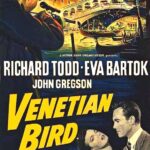Dir: Peter Graham Scott | Cast: Adrienne Corri, William Russell, Ian Colin, Penelope Bartley | UK Drama 59′
Yet another long-forgotten gem doing the rounds on Talking Pictures, the big chance – seized by both with both hands – those of director Peter Graham Scott and leading man William Russell (back then starting to make a name for himself as TVs Sir Lancelot).
Although billed second to femme fatale Adrienne Corri, Russell carries the film just like Joseph Cotton did in Andrew Stone’s The Steel Trap five years earlier, which seems to be its model; dreaming of escape to Honolulu, as Cotton had wanted to get away to Rio. Except here it gets even more complicated than Stone’s film when Corri enters the picture as a high maintenance dame in a fur coat.
Like Stone’s film vividly shot on location, the feature’s rough edges simply enhance the drama; and instead of Dimitri Tiomkin thundering away on the soundtrack we initially get Russell himself narrating the action (actually anticipating Stone’s Cry Terror the following year) and Eric Spear bringing out the cornet he later immortalised in his theme for ‘Coronation Street’.
Amazingly this all is all dealt with in under an hour during which you haven’t the foggiest idea how it’s all going to resolve itself; frequently thinking, as it grows more relentless, that it’s all going to have turned out to be a dream. Or a nightmare. @Richard Chatten
NOW ON TALKING PICTURES TV

